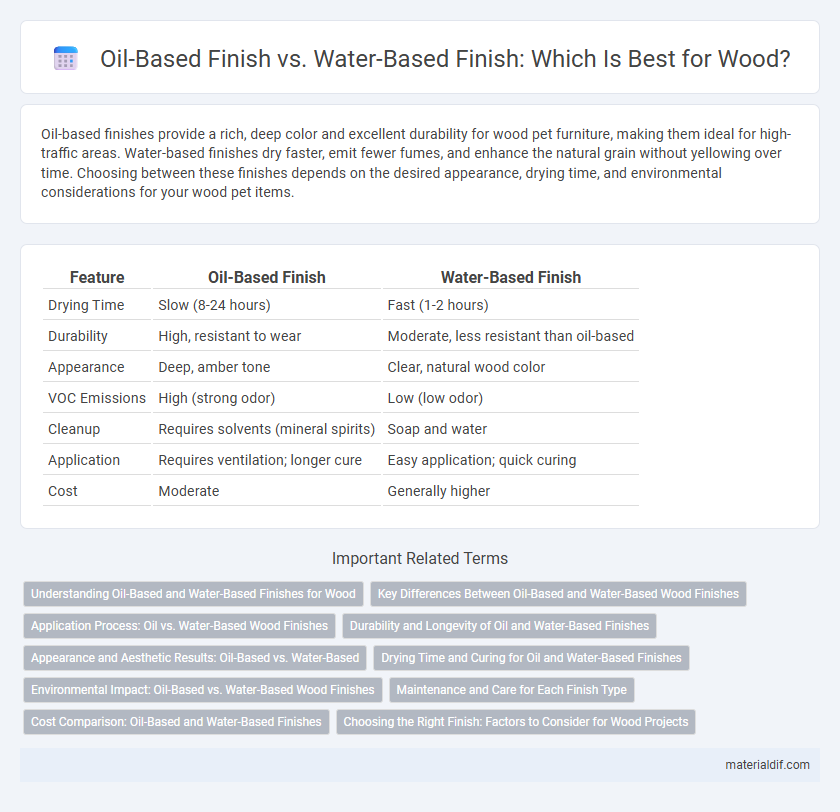Oil-based finishes provide a rich, deep color and excellent durability for wood pet furniture, making them ideal for high-traffic areas. Water-based finishes dry faster, emit fewer fumes, and enhance the natural grain without yellowing over time. Choosing between these finishes depends on the desired appearance, drying time, and environmental considerations for your wood pet items.
Table of Comparison
| Feature | Oil-Based Finish | Water-Based Finish |
|---|---|---|
| Drying Time | Slow (8-24 hours) | Fast (1-2 hours) |
| Durability | High, resistant to wear | Moderate, less resistant than oil-based |
| Appearance | Deep, amber tone | Clear, natural wood color |
| VOC Emissions | High (strong odor) | Low (low odor) |
| Cleanup | Requires solvents (mineral spirits) | Soap and water |
| Application | Requires ventilation; longer cure | Easy application; quick curing |
| Cost | Moderate | Generally higher |
Understanding Oil-Based and Water-Based Finishes for Wood
Oil-based finishes penetrate deeply into wood fibers, providing a rich, durable coating that enhances natural grain and offers strong protection against wear and moisture. Water-based finishes dry faster, emit fewer volatile organic compounds (VOCs), and maintain the wood's natural color without yellowing over time. Choosing between oil-based and water-based finishes depends on the desired appearance, durability needs, and environmental considerations.
Key Differences Between Oil-Based and Water-Based Wood Finishes
Oil-based wood finishes offer deeper penetration and enhanced durability, often resulting in a richer amber hue that ages gracefully over time. Water-based finishes dry faster, emit lower levels of volatile organic compounds (VOCs), and maintain the wood's natural color with minimal yellowing. Both finishes differ significantly in application, cleanup methods--oil requires solvents while water cleans with soap and water--and environmental impact, making them suitable for varying project needs and preferences.
Application Process: Oil vs. Water-Based Wood Finishes
Oil-based wood finishes penetrate deeply into the wood grain, requiring longer drying times and multiple coats for full protection and enhanced durability. Water-based finishes dry faster, offer easier cleanup with soap and water, and provide a clear, non-yellowing coat suitable for light-colored woods. Application of oil-based finishes typically involves brush or cloth rubbing to ensure absorption, while water-based finishes allow for smooth, even layers using synthetic brushes or sprayers.
Durability and Longevity of Oil and Water-Based Finishes
Oil-based finishes penetrate deeply into wood fibers, creating a robust, durable barrier that resists wear, scratches, and moisture over time. Water-based finishes dry faster and provide a clear, non-yellowing coat but generally offer less durability and may require more frequent reapplications in high-traffic areas. For long-lasting protection, oil-based finishes are preferred in environments requiring enhanced resilience and resistance to damage.
Appearance and Aesthetic Results: Oil-Based vs. Water-Based
Oil-based finishes penetrate deeply into wood, enhancing natural grain patterns with a warm, amber tone that intensifies over time, providing a rich and classic appearance. Water-based finishes offer a clearer, more transparent coating that preserves the wood's natural color and offers a modern, less yellowed aesthetic. The choice between oil-based and water-based finishes significantly affects the final look, with oil-based suited for traditional, warm hues and water-based preferred for maintaining brightness and clarity.
Drying Time and Curing for Oil and Water-Based Finishes
Oil-based finishes typically require 8 to 24 hours to dry and up to 30 days to fully cure, providing a durable, hard finish ideal for high-traffic wood surfaces. Water-based finishes dry much faster, often within 1 to 2 hours, and cure completely in about 7 days, offering quicker project completion with lower VOC emissions. Understanding these drying and curing times is essential for selecting the appropriate finish based on project deadlines and wood usage conditions.
Environmental Impact: Oil-Based vs. Water-Based Wood Finishes
Oil-based wood finishes release higher levels of volatile organic compounds (VOCs), contributing to air pollution and health risks, whereas water-based finishes emit significantly fewer VOCs, making them more environmentally friendly. The slower curing time of oil-based finishes results in prolonged solvent evaporation, intensifying environmental impact compared to the quicker drying and lower toxicity of water-based alternatives. Choosing water-based wood finishes reduces hazardous emissions and supports sustainable practices in woodworking and home improvement.
Maintenance and Care for Each Finish Type
Oil-based finishes require periodic reapplication and regular cleaning with a mild solvent to maintain their rich appearance, as they tend to darken and develop a patina over time. Water-based finishes demand frequent gentle cleaning with a damp cloth and avoid harsh chemicals to preserve their clear, non-yellowing surface, offering easier spot repairs and faster drying times. Proper maintenance of each finish type extends the wood's lifespan and enhances durability against moisture, scratches, and stains.
Cost Comparison: Oil-Based and Water-Based Finishes
Oil-based finishes generally cost more upfront due to higher prices of solvents and longer drying times that increase labor expenses, while water-based finishes tend to be more cost-effective with lower material prices and faster application. However, oil-based finishes often require fewer coats, potentially balancing the overall cost, whereas water-based finishes may need multiple applications for equivalent durability. Long-term maintenance costs can also vary, as oil-based finishes offer strong resistance to wear but may need reapplication more frequently depending on environmental factors.
Choosing the Right Finish: Factors to Consider for Wood Projects
When choosing between oil-based and water-based finishes for wood projects, consider factors such as durability, drying time, and environmental impact. Oil-based finishes offer enhanced protection and richer color depth but require longer curing times and emit higher VOCs, while water-based finishes dry quickly, have lower odor, and are more environmentally friendly. The type of wood, intended use, and desired aesthetic influence the optimal finish choice, with hardwoods benefiting from oil-based finishes and softwoods often suited to water-based products.
Oil-Based Finish vs Water-Based Finish Infographic

 materialdif.com
materialdif.com